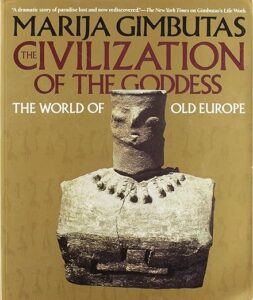The Civilization of the Goddess: The World of Old Europe
Author: Marija Gimbutas
Year: 1994
 In this classic of 20th-century archaeology Gimbutas uncovers the world of Old European civilization, which spread from the Ukraine to the Balkans thousands of years before the city states of Mesopotamia. She traces the main stream of Neolithic culture flowed up the Balkans to the Danube before 6000 BCE. In the lower Danube Valley, hundreds of villages emerged like a new flora in the woods. Some were tiny hamlets. and others could house 5,000 people. In northern Hungary near the Carpathan Mountains, a Bukk culture of the 5000s BCE seems to illustrate the merging of prehistoric cave dwellers with neolithic farmers. The graves show a mixture of light-boned Mediterranean people, and heavier-boned descendants of the Cro-Magnon population. The settlements were of one- or two-story houses, but caves were occupied as well. The villagers lived off gardens, hunting, and also the mineral resources of caves. The caves were used as sanctuaries for traditional religion, but also as mines for flint, quartz (for crystals and blades), and, by about 5500 BCE, copper. I wonder if such a mixture of cultures, races, and technologies, gave rise to a mythology of forest elves, mountain dwarves and “true people.”
In this classic of 20th-century archaeology Gimbutas uncovers the world of Old European civilization, which spread from the Ukraine to the Balkans thousands of years before the city states of Mesopotamia. She traces the main stream of Neolithic culture flowed up the Balkans to the Danube before 6000 BCE. In the lower Danube Valley, hundreds of villages emerged like a new flora in the woods. Some were tiny hamlets. and others could house 5,000 people. In northern Hungary near the Carpathan Mountains, a Bukk culture of the 5000s BCE seems to illustrate the merging of prehistoric cave dwellers with neolithic farmers. The graves show a mixture of light-boned Mediterranean people, and heavier-boned descendants of the Cro-Magnon population. The settlements were of one- or two-story houses, but caves were occupied as well. The villagers lived off gardens, hunting, and also the mineral resources of caves. The caves were used as sanctuaries for traditional religion, but also as mines for flint, quartz (for crystals and blades), and, by about 5500 BCE, copper. I wonder if such a mixture of cultures, races, and technologies, gave rise to a mythology of forest elves, mountain dwarves and “true people.”
Around 4800 BCE, farming cultures from the Balkans moved into the Ukraine, and found their most fertile fields. The Ukraine was a gardener’s paradise. The threat of raiders from the treeless steppes had not yet appeared. The arid steppes were only starting to form in the far-off Volga-Donets region. The gardening civilization met no environmental limits except to the north. By 3500 BCE, a 9,000 square-kilometer area of the Uman district held 253 villages of the Cucuteni culture. Some communities had thousands of houses. One site near Tallyanky covered five and a half square kilometers and could have housed 10,000 people. Since the land was vast and rich, there was probably no reason for conflict over any particular plot of ground. The methods of gardening and animal raising were a boon to all who learned them. The villages had no walls, and stood in open fields beside the rivers.n




